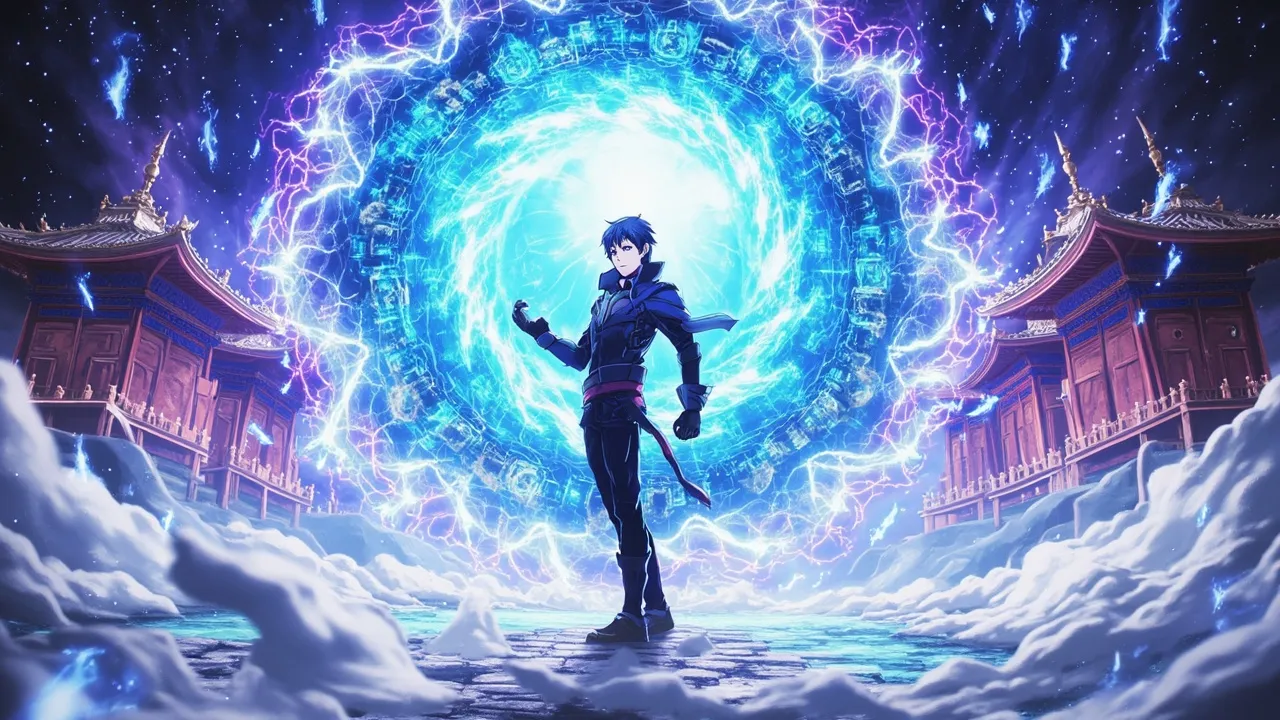Teleportation Portal Creation

Teleportation Portal Creation Video Demo 🎬
Table of Contents
- Teleportation Portal Creation Video Demo 🎬
- What Is Teleportation Portal Creation
- Core Abilities of Teleportation Portal Creation
- Application / Tactical Advantages in Combat
- Level: Level 1 🏙️, Level 2 🌇, Level 3 🌃
- Limitations of Using the Teleportation Portal Creation
- Weakness Against What Other Superpowers
- Synergistic Power Combos
- Known Users
Teleportation Portal Creation is the superpower to open stable gateways that link two points in space—or even dimensions—allowing instant travel without crossing the intervening distance. Unlike blink-style teleportation, which moves a single target directly, this power manifests visible portals, jump gates, or spatial rifts that anyone or anything can pass through. In simple terms: it draws a door in reality. Fans exploring similar abilities can browse the full catalogue in the superpower wiki, or try the random superpower generator to discover unexpected combinations.
What Is Teleportation Portal Creation
Teleportation Portal Creation refers to forming temporary or persistent portals between two locations. The wielder shapes a gateway—often a ring, disc, oval, or shimmering frame—that acts as a short-lived corridor through folded space. It is synonymous with terms like portal generation, gateway creation, wormhole creation, and spatial rift formation. Depending on mastery, the user can range from short-hop line-of-sight teleportation to long-range intercontinental links, and, at higher tiers, interdimensional travel.
Key differences from standard teleportation include:
-
Externalized travel path: Others may use the portal; it’s not limited to the caster.
-
Visible and interactable: Portals can be defended, sabotaged, or blocked.
-
Environmental transfer: Air, water, light, sound, and matter can pass through, enabling creative tactics and risks.
Core Abilities of Teleportation Portal Creation
Portal Generation & Placement
The user opens two (or more) paired apertures that instantly connect distant coordinates. Placement can be freehand, targeted at a marked waypoint, or anchored to surfaces. Advanced users employ beacons or waypoint anchors for repeatable links.
Range & Precision Control
Beginners often require line-of-sight or a clear mental image; experts utilize maps, coordinates, or known anchor points for long-range teleportation. Precision determines whether a portal opens safely on solid ground or disastrously inside matter (usually prevented by built-in spatial failsafes).
Portal Stabilization
Portals tend to wobble or collapse under stress. Stabilization includes widening the aperture, reinforcing edges, and smoothing the curvature of space to reduce turbulence. Skilled users can hold macro-portals open for minutes, while micro-portals can flicker open for a fraction of a second.
Momentum & Orientation Management
Good control lets travelers keep orientation (up/down), conserve or cancel momentum, and avoid motion sickness. Some users can perform inertia dumping—bleeding excess speed across edges—preventing high-velocity crashes on exit.
Multi-Portal Networks
Higher mastery allows daisy-chaining multiple gates, creating hub-and-spoke networks. The caster can lock portals to follow moving targets (e.g., mount a portal to a vehicle) or remain stationary as fixed gateways.
Interdimensional Access
At elite levels, the user can open portals to pocket dimensions, mirror realms, or parallel worlds, though these require massively higher energy and precise shielding against hostile physics.
Application / Tactical Advantages in Combat
Battlefield Mobility
-
Instant flanking: Teams step through and appear behind enemy lines.
-
Rapid extraction: Evacuate wounded allies to safe zones faster than any vehicle.
-
Terrain negation: Walls, cliffs, rivers, and minefields become irrelevant.
Spatial Manipulation Tricks
-
Redirection: Reroute projectiles, shockwaves, or energy beams into empty space or back toward their source.
-
Drop attacks: Open a portal above a target to drop heavy objects (or water) from elsewhere.
-
Environmental import: Pull in fog, sand, or smoke to create visual cover.
Control & Denial
-
Choke points: Narrow portals force opponents to funnel into predictable lanes.
-
Decoy gates: Fake or short-lived portals bait enemies into traps.
-
Geofencing: Restrict portal exits to pre-cleared safe zones to prevent ambushes.
Utility Outside Combat
-
Logistics: Move supplies, vehicles, and construction equipment.
-
Rescue: Bridge collapsed structures or flooded regions.
-
Science & exploration: Sample hostile environments via tethered micro-portals.
Level: Level 1 🏙️, Level 2 🌇, Level 3 🌃
Level 1 🏙️ — Street-Scale Gatecaster

-
Capabilities: Short-range (up to a city block or two), line-of-sight or memory of recently visited locations. Portals roughly door-sized, stable for a few seconds.
-
Control: Requires focus; edges shimmer; occasional drift.
-
Tactics: Quick escapes, alley-to-rooftop repositioning, small-object redirection, one- or two-person transport.
-
Risks: Misplacement in tight quarters; fatigue after repeated casts.
Level 2 🌇 — City-to-City Wayfinder

-
Capabilities: Multi-kilometer range, coordinate-based placement, reliable stabilization. Supports teams and light vehicles; minute-long gates possible.
-
Control: Can orient gravity and conserve/cancel moderate momentum. Uses beacons/anchors for pre-mapped hubs.
-
Tactics: Coordinated strikes, supply corridors, drone-portal scouting, multi-portal feints.
-
Risks: Greater energy draw; interference from electromagnetic storms or spatial distortion zones; increasing vulnerability to enemy anti-teleport wards.
Level 3 🌃 — Interdimensional Gatewright

-
Capabilities: Continental or interplanetary spans with robust stabilization. Opens macro-portals for heavy logistics and micro-portals for precision tasks (like bullet redirection). Limited interdimensional access with protective seals.
-
Control: Fine-grained momentum management, pressure equalization, atmosphere filtering, timed one-way gates, and portal “locks” keyed to allies.
-
Tactics: Blitzkrieg deployments, mass evacuations, redirecting superweapons, creating safe corridors through hazardous biomes, conducting cross-reality reconnaissance.
-
Risks: Catastrophic backlash on failure; dimensional contamination if seals collapse; complex cooldown and recovery windows.
Limitations of Using the Teleportation Portal Creation
-
Energy Cost & Cooldown: Each gate drains stamina or power reserves. Larger apertures, longer distances, and longer durations demand exponentially more energy. Cooldowns prevent spamming.
-
Environmental Sensitivity: Solar storms, geomagnetic anomalies, void pockets, and gravity wells destabilize portals. Thick shielding, enchanted barriers, or high-tech jammers can scramble coordinates.
-
Line-of-Sight / Knowledge Requirement: Many casters must either see the destination, have visited it, or lock onto a beacon. Unknown, moving, or shielded targets are hard to access.
-
Safety Protocols: Built-in failsafes try to prevent opening inside solid matter, but interference can cause misfires that shunt the portal aside or collapse it early.
-
Payload Limit: Aperture size and structural integrity cap what can pass through. Overloading can shear the edge, injuring travelers or slicing cargo.
-
Two-Way Exposure: Unless configured as one-way, portals allow threats to come back through. Proper gating, shutters, or directional flow is essential.
-
Sound/Light/Atmosphere Transfer: Pressure, gas, and thermal differences may rush through. Without equalization, sudden blasts of wind or flashover heat can occur.
Weakness Against What Other Superpowers
-
Teleportation Nullification / Anti-Portal Fields: Dedicated jammers, null-magic, or dampening auras prevent portals from forming or hold them to a tiny, useless size.
-
Gravity Manipulation: Variable gravity or gravity wells twist portal curvature, causing drift, collapse, or hazardous shear at the rim.
-
Reality Anchoring / Dimensional Lock: Powers that “pin” local reality (reality anchoring, dimensional lock, or anti-phase seals) block interdimensional portals outright.
-
Chaos / Probability Manipulation: Randomizes exit positions or timing, turning precise logistics into unreliable gambles.
-
Time Distortion: Desynchronizes entrance and exit, leading to lag, time loops, or temporal desync sickness.
-
Hard Light / Force Constructs: Solid barriers can cap an exit aperture or encase a portal edge, preventing traversal or weaponizing the rim.
-
Psionic Disruption: If casting relies on concentration, telepathy or fear induction can interrupt mid-cast.
Synergistic Power Combos
-
Precognition + Portal Casting: Foreknowledge of enemy moves enables perfect counter-ports, redirecting attacks before they’re launched.
-
Telekinesis + Micro-Portals: Insert tiny portals in front of projectiles, then telekinetically steer their new trajectories.
-
Elemental Manipulation + Gates: Flood a battlefield with mist or sand from distant sources, or vent wildfire smoke into vacuum.
-
Technomancy / Sensors + Anchors: Satellite mapping, drones, or arcane scrying feed exact coordinates and threat data to portal targeting.
-
Invisibility or Stealth Suits + One-Way Gates: Silent infiltration routes where only allies can exit.
-
Healing + Evac Corridors: Create protected, one-direction corridors to field hospitals for rapid triage.
-
Gravity Control + Momentum Management: Cancel dangerous velocities or add controlled acceleration by gating through inclined frames.
Known Users
-
A notable comic example is Blink (Clarice Ferguson), who creates crystalline portals for travel and combat redirection. Learn more about the character on Blink’s profile.
-
Other fictional gatewrights include sorcerers who open mirror-like doorways, spacefaring engineers who deploy jump gates, and portal-archers who fire temporary rifts with specialized arrows. Their portrayals vary widely, but common threads include waypoint anchors, stabilization rituals, and strict safety rules to prevent misfires.
By understanding Teleportation Portal Creation—its core abilities, tactical uses, levels of mastery, limitations, counters, and synergies—world-builders and players can design balanced scenarios that reward creativity without breaking the setting’s logic. For adjacent abilities, explore the evolving superpower wiki, or spark ideas with a spin of the random superpower generator.
